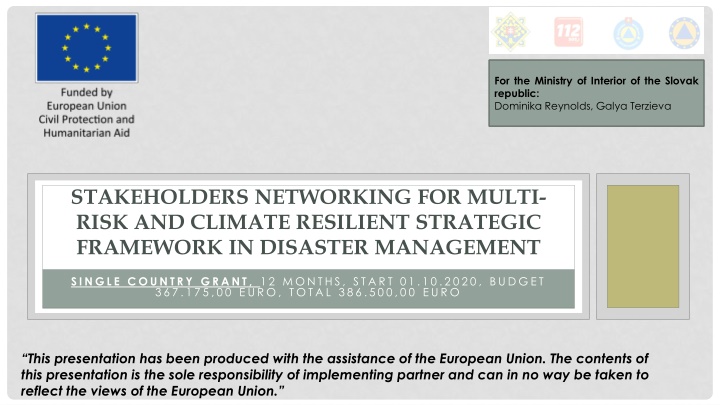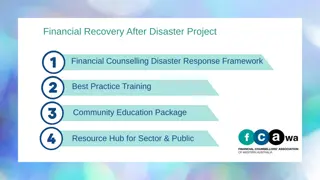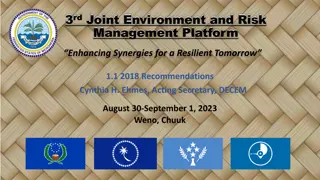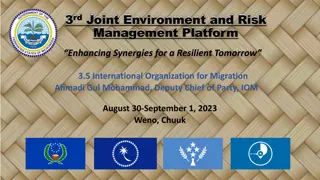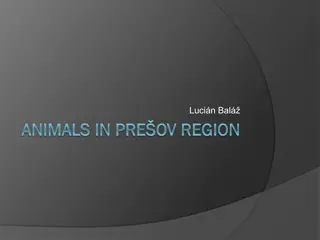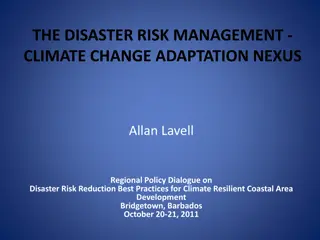Stakeholders Networking for Multi-Risk and Climate Resilient Disaster Management in Slovakia
This project, funded by the European Union, aims to enhance emergency preparedness and response in Slovakia by addressing institutional capacity, coordination, and technology gaps. The goal is to strengthen risk assessment methodologies, involve various stakeholders, and develop disaster-resilient management guidelines. Work packages include developing a disaster risk management plan and assessing investment needs for risk management measures. Additionally, studies will be conducted to enhance policies and legislation for disaster and climate resilience.
Download Presentation

Please find below an Image/Link to download the presentation.
The content on the website is provided AS IS for your information and personal use only. It may not be sold, licensed, or shared on other websites without obtaining consent from the author.If you encounter any issues during the download, it is possible that the publisher has removed the file from their server.
You are allowed to download the files provided on this website for personal or commercial use, subject to the condition that they are used lawfully. All files are the property of their respective owners.
The content on the website is provided AS IS for your information and personal use only. It may not be sold, licensed, or shared on other websites without obtaining consent from the author.
E N D
Presentation Transcript
For the Ministry of Interior of the Slovak republic: Dominika Reynolds, Galya Terzieva STAKEHOLDERS NETWORKING FOR MULTI- RISK AND CLIMATE RESILIENT STRATEGIC FRAMEWORK IN DISASTER MANAGEMENT SINGLE COUNTR Y GR ANT, 12 M O NTHS, STA R T 01.10.2 0 20 , B U DGET 367.175 ,0 0 EU R O , TO TA L 386.500 ,0 0 EU R O This presentation has been produced with the assistance of the European Union. The contents of this presentation is the sole responsibility of implementing partner and can in no way be taken to reflect the views of the European Union.
NEEDS General need of better emergency preparedness, prevention and response; Insufficient institutional and technical capacity for strategic disaster prevention and preparedness activities; Lack of communication and data sharing between stakeholder approach (common DRR platform); Absence of a communication mechanisms for risk assessment; Lack of coordination; Lack of legal and policy papers unification; CBRN events and climate changes needs to be embedded in the disaster reduction national plans; Lack of technologies in DRR, lack of proper planning; Lack of expertise discussion and a roadmap for public financing in the field of DRR.
GOAL Strengthen, modernise and adopt a risk assessment plan and methodology to the needs of emergency preparedness, prevention and response; Lay the foundation of a multi-stakeholder involvement dealt with by different government agencies, research institutions, NGOs ; Methods and approaches to risk assessments, good practice examples identified in national risk assessment approaches; Development of standard criteria for risks assessment on a regional level and the systematic collection of data; Development and application of disaster-resilient management guidelines to improve the ability of stakeholders to monitor, anticipate and learn from crises, and thereby allow them to adapt and respond more effectively and operate more efficiently during disasters.
WORK PACKAGES + ACTIVITIES WP1: Developing a multi-risk and risk-specific disaster risk management plan + enabling conditions for investing in risk management measures under the next cycle of European Cohesion Policy Funds (2021-2027); Activities: Activity 1.1. Collecting data and assessment of regional capacities and stakeholders Activity 1.2 Mapping investment needs for risk management measures Activity 1.3 Developing a multi-risk and risk-specific disaster risk management plan (National Comprehensive Disaster Risk Assessment and Management Plan) WP2: Ensuring studies and assessments required to develop policies, legislation and/or measures for disaster and climate resilience. Activities: Activity 2.1 Review of the existing policies, legislation and climate resilience measures Activity 2.2 Producing a study with the recommendation for modernisation of policies, legislation and resilient measures. WP3: Communication and public diplomacy Activities: Activity 3.1 Draft of a communication strategy
HOW TO? - IMPLEMENTATION APPROACH Work within work packages (WP) is to be organised in form of 4 consultative working groups (WG) contributing to all WPs: WG1: Technologies for reducing the risks associated with climate change, technological threats, biological threats (4 meetings / year + 1 recommendation material) WG2: Risk analysis - revision and improvement of risk assessment methodology (4 meetings / year + 1 recommendation material) WG3: DRR management and communication at all levels - analysis and recommendations (4 meetings / year + 1 recommendation material + foundation of a framework for disaster risk management and monitoring + development of a risk management plan with different risks and specific risks, including investment risk management measures under the next cycle of European Cohesion Policy Funds (2021-2027) WG4: Legislative Working Group (6 meetings / year)
